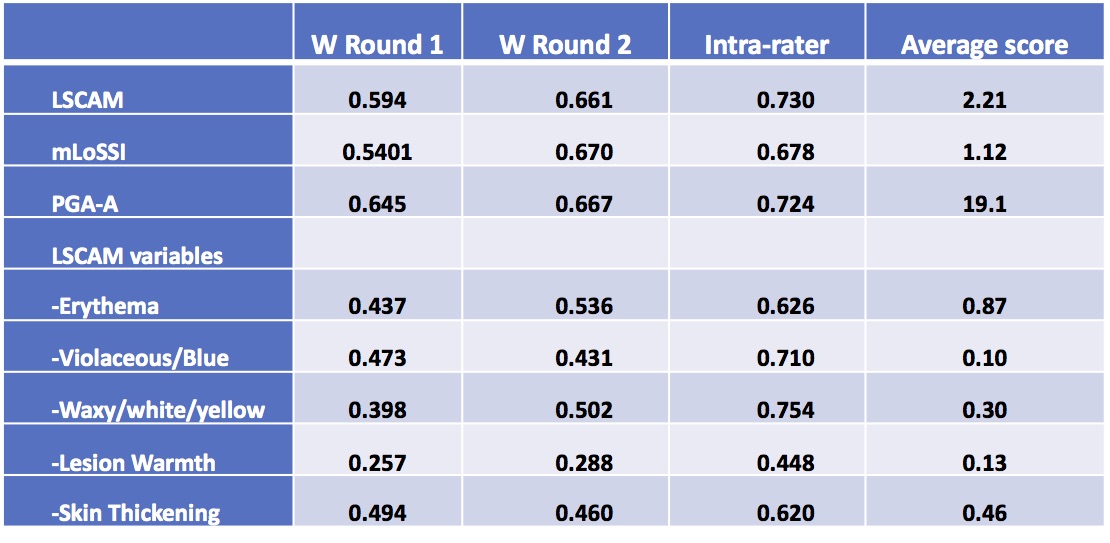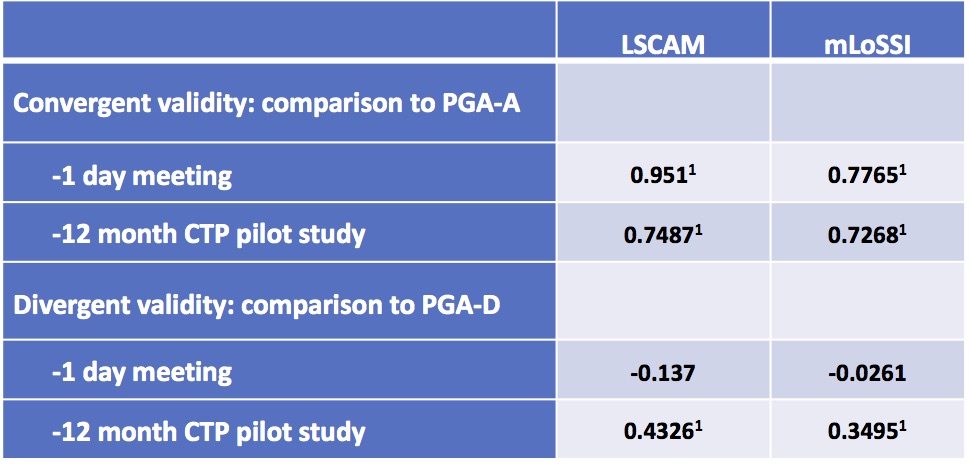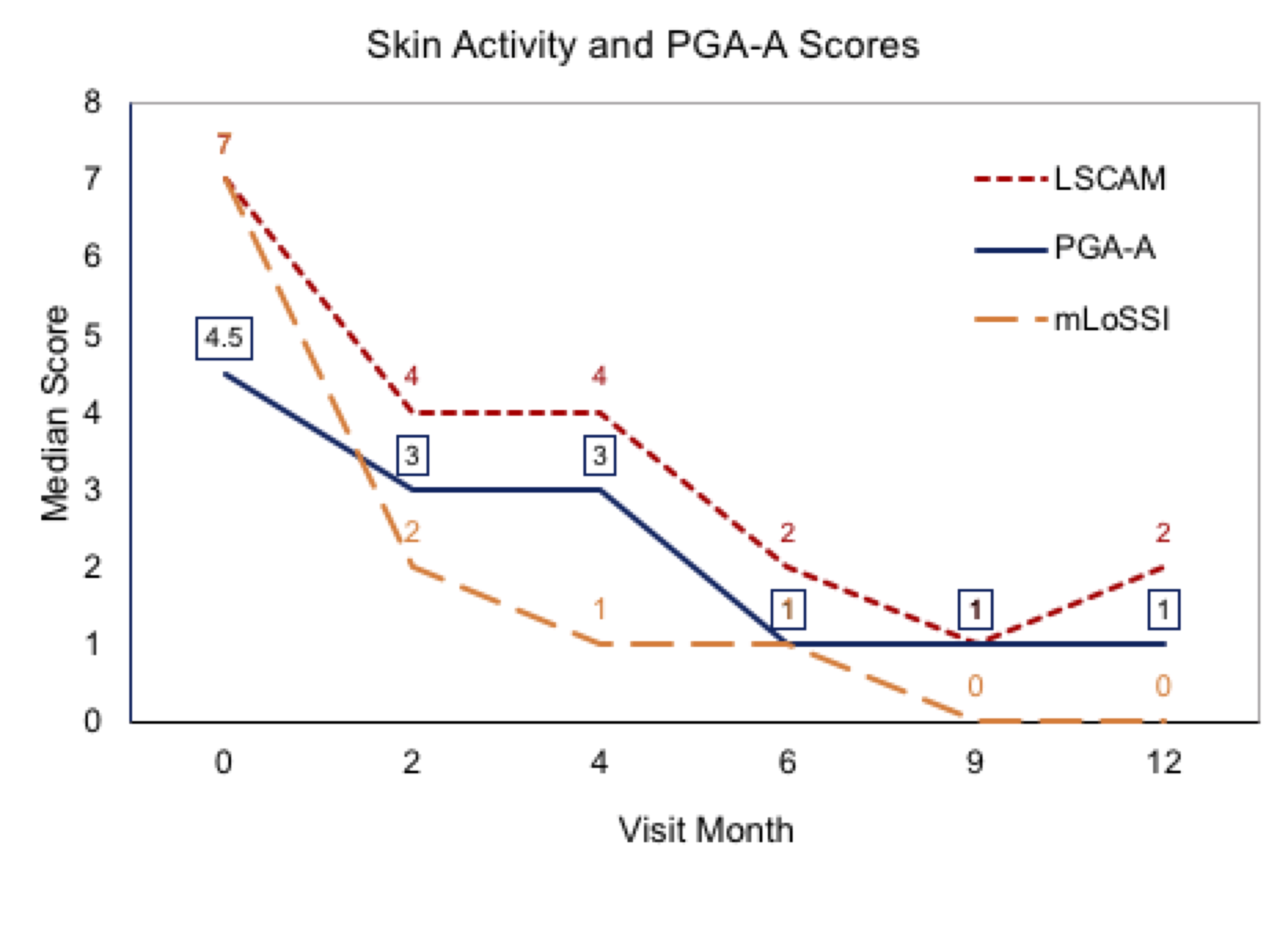Session Information
The 2020 Pediatric Rheumatology Symposium, originally scheduled for April 29 – May 2, was postponed due to COVID-19; therefore, abstracts were not presented as scheduled.
Date: Friday, May 1, 2020
Title: Poster Session 2
Session Type: ACR Abstract Session
Session Time: 5:00PM-6:00PM
Background/Purpose: Juvenile localized scleroderma (jLS) is a chronic inflammatory and fibrosing disease. Treatment is directed towards controlling disease activity to minimize risk for functional impairment and severe damage. To work towards identifying optimal therapy, sensitive disease measures are needed to allow for comparative effectiveness studies.
A prior study identified erythema, violaceous color, tactile warmth, waxy white/yellow, and skin thickening (ST) as features tracking with disease activity. The LS CARRA group developed a skin activity measure, LS Cutaneous Activity Measure (LSCAM), based upon these variables. We report its performance in two prospective cohorts.
Methods: The LSCAM was modelled after the modified Localized Scleroderma Scoring Index (mLoSSI). The variables are scored in affected sites with the body divided into 19 anatomic sites. Unlike mLoSSI, there is no weighting of variables; all are summed equally across sites. Reliaibity of scoring of LSCAM was evaluated in a 1-day meeting where, following a training session, 14 physicians scored 13 jLS patient volunteers twice. Each scorer was given a photo scoring atlas to aid standardization of scoring. Construct validity was determined by comparison of LSCAM to Physician Global Assessment of disease activity (PGA-A) and disease damage (PGA-D) in two cohorts: the patient volunteers as described, and a cohort of jLS patients beginning methotrexate-based treatment and followed for 12 months (consensus treatment plan pilot study, CTP pilot). We calculated Kendall’s coefficient of concordance to assess inter-rater reliability, and Spearman’s rho to assess intra-rater reliability and validity. Levels of 0.2 to < 0.4 were considered poor, 0.4 to < 0.6 moderate, 0.6 to 0.8 good, and >0.8 excellent.
Results: A moderate to good level of inter-rater reliability of scoring of LSCAM and mLoSSI was found in both rounds at the meeting (Table 1). A good level of intra-rater reliabiilty of scoring was found for LSCAM, mLoSSI, and PGA-A. Among the individual variables, all except waxy white or yellow and tactile warmth had moderate reliability in both rounds (Table 1). Intra-rater was higher than inter-rater reliabiity (Tablle 1).
Excellent convergent construct validity was found between LSCAM and PGA-A, and good between mLoSSI and PGA-A in the 1-day meeting (Table 2). Good construct validity was found for LSCAM and mLoSSI in the CTP Pilot (Table 2). Divergent construct validity with PGA-D was shown between LSCAM and mLoSSI in the meeting, but not in the CTP Pilot (LSCAM 0.433, mLoSSI 0.350, Table 2). A plot of LSCAM, mLoSSI, and PGA-A scores from the CTP Pilot showed the scores for all measures decreased over time (Figure 1). LSCAM appeared to more closely mirror changes in PGA-A score than mLoSSI.
Conclusion: LSCAM is a reliable and valid measure for assessing cutaneous activity in jLS. The level of inter- and intra-rater reliability of LSCAM was similar to greater than mLoSSI. A similar to higher level of convergent construct validity with PGA-A was found for LSCAM compared to mLoSSI, with LSCAM appearing to track better with PGA-A scores in the 12 month study. Our findings suggest the LSCAM will aid monitoring of LS activity, and be useful in comparative treatment studies.
Thirteen jLS patient volunteers were evaluated two times in a one day meeting by 14 raters: 13 pediatric rheumatologists, 1 pediatric dermatologist. To enable the two scoring sessions to be held on the same day, a maximum of two anatomic sites were evaluated per patient, with these sites identified in advance by one of the investigators (K. Torok). PGA_A was scored from 0_100. The average score of each measure and variable for the patients is shown; Erythema and skin thickening were scored from 0_3, other variables were scored from 0_1. Patients were evaluated in a different random order by each rater in the two rounds.
For inter_rater reliability, Kendall’s coefficient of concordance (W ) were calculated. For Intra_rater reliability, Spearman’s correlation were calculated for each rater, and average score of each measure or variable across all patient volunteers shown. All reliability values shown were found significant, p <0.0001.
LSCAM: Localized scleroderma cutaneous activity measure
mLoSSI: modified localized scleroderma severity index
PGA_A = Physician global assessment of disease activity
LSCAM and mLoSSI scores were analyzed in comparison to PGA_A for convergent validity, and to PGA_D for divergent validity in the two prospective jLS cohorts: 13 patient volunteers in a one day meeting, and 44 jLS patients initiating methotrexate treatment in the jLS CTP pilot study. Spearman’s rho correlation coefficients are shown. Superscript 1 indicates p < 0.001.
LSCAM: Localized scleroderma cutaneous activity measure
mLoSSI: modified localized scleroderma severity index
PGA_A = Physician global assessment of disease activity
PGA_D = Physician global assessment of disease damage
The jLS Consensus Treatment Plan (CTP) study followed jLS patients for 12 months after then initiated methotrexate treatment (one of three methotrexate_based CTPs). Forty_four patients completed 12 months of treatment. The median LSCAM, mLoSSI, and PGA_A scores of these jLS patients is shown.
CTP: consensus treatment plan
LSCAM: Localized scleroderma cutaneous activity measure
mLoSSI: modified localized scleroderma severity index
PGA_A: physician global assessment of disease activity
To cite this abstract in AMA style:
Li S, Becker M, Hong S, Ferguson P, Nyrienda T, Andrews T, Stewart K, Rabinovich C, Fuhlbrigge R, Mason T, Pope E, Ibarra M, Dedeoglu F, Higgins G, Laxer R, Punaro M, Torok K. Reliability and Validity of a New Skin Activity Measure for Localized Scleroderma [abstract]. Arthritis Rheumatol. 2020; 72 (suppl 4). https://acrabstracts.org/abstract/reliability-and-validity-of-a-new-skin-activity-measure-for-localized-scleroderma/. Accessed .« Back to 2020 Pediatric Rheumatology Symposium
ACR Meeting Abstracts - https://acrabstracts.org/abstract/reliability-and-validity-of-a-new-skin-activity-measure-for-localized-scleroderma/



